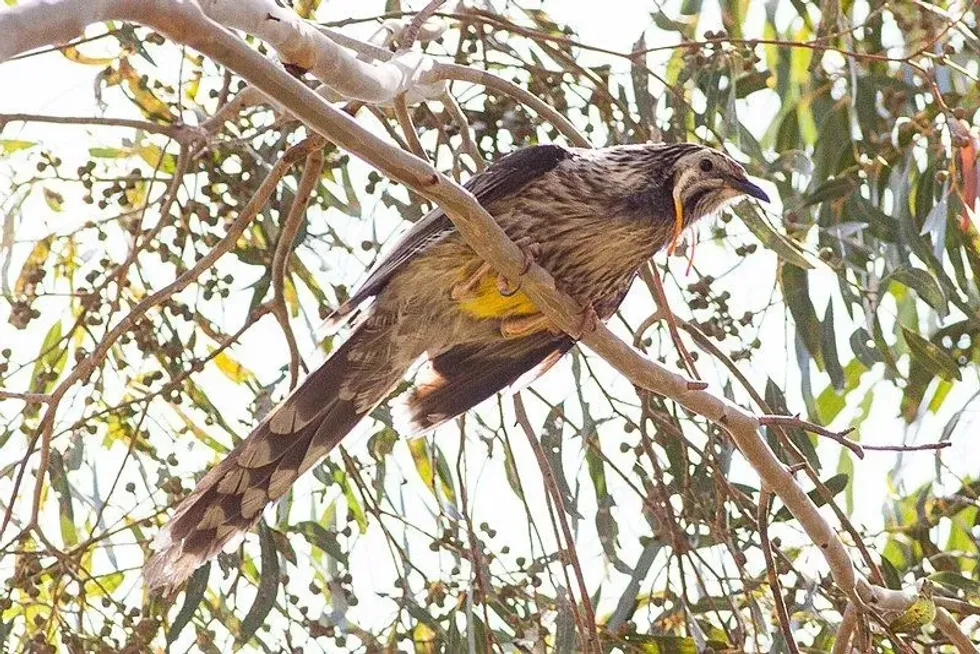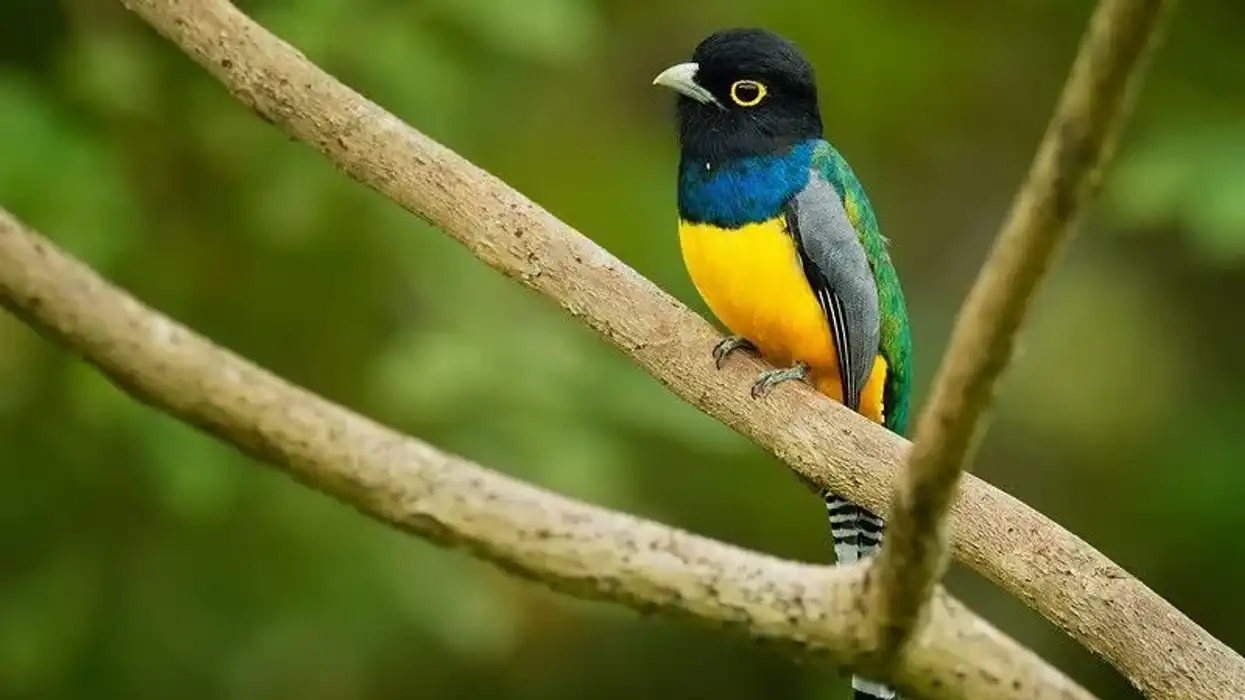The yellow wattlebird, Anthochaera paradoxa, was first described by the French zoologist, Francois Marie Daudin, in 1800. It was first classified as the Corvus paradox. The yellow wattlebird is Australia's well-known honeyeater bird. It is native to the country of Australia and is commonly seen in the east and central parts of Australia.
They have long narrow yellow wattles on their heads. They are gray to dusky brown in color with white strikes on their flight feathers.
The young yellow wattlebirds have small wattles with a paler head and the adults are brighter during the breeding season. The female yellow wattlebird is much smaller than her male counterparts. These birds are tamed and seen in rural and urban areas.
The yellow wattlebirds are solitary and feed on fruits, nectar, honey, and insects. They are mostly seen around eucalyptus trees and shrubland in coastal areas. They are not rare and are Least Concern on the list by the IUCN.
If you enjoy reading this article, then learn some interesting facts about other birds, such as the Cambodian tailorbird and the sunbird.
Yellow Wattlebird Interesting Facts
What type of animal is a yellow wattlebird?
The yellow wattlebird is Australia's nomadic bird and honeyeater. They are also known as long wattlebirds and Tasmanian wattlebirds. Their name comes from the yellow wattles which can be seen on their heads.
What class of animal does a yellow wattlebird belong to?
The yellow wattlebird, Anthochaera paradoxa, belongs to the class of Aves and the order Passeriformes. It is from the family of Meliphagidae and the genus Anthochaera.
How many yellow wattlebirds are there in the world?
There are many yellow wattlebirds around their native place as they are on the Least Concern list by the IUCN. The exact number is not estimated and is unknown globally.
Where does a yellow wattlebird live?
They were known as Tasmanian wattlebirds before, but are now endemic to Tasmania. They are commonly seen in the east and central parts of Australia. These nomadic birds are widespread in Australia but less seen in western areas. They were spotted near the Southern Mornington Peninsula in Victoria.
What is a yellow wattlebird's habitat?
The yellow wattlebird's habitat is wide, from low lands to high canopies of trees. They are seen in dry woodlands, wet temperate rainforests, subalpine forests, shrub areas, and orchards. They are even spotted in coastal areas, inland heathland, and shrubland.
Who do yellow wattlebirds live with?
The yellow wattlebird, Anthochaera paradoxa, is a very territorial and solitary bird that lives in pairs. They are rarely seen in flocks while foraging for food. They lay two to three eggs in a clutch.
How long does a yellow wattlebird live?
The yellow wattlebird life span evidence is not available and is assumed to live up to 11 years as any bird.
How do they reproduce?
The yellow wattlebird breeding season is from the month of August to January. The eggs of these birds can be seen from the month of September to November.
The young yellow wattlebird fledglings can be seen around in the months of October to January. They build nests as solitary pairs.
They are very elusive, territorial, and thus try to defend their territory and chase away intruders. The nest is solely made by the female and is a deep, shallow nest made with twigs, feathers, wool, and dry grass. Their nest can be seen at a height of 59 ft (18 m), mostly found in trees and shrubs.
The female lays around two to three eggs in a clutch and incubation lasts for 14-16 days. Once the eggs are hatched, they are taken care of by both parents.
Their nestling period is 18-21 days. The male yellow wattlebirds species are less seen contributing to the whole process of breeding.
What is their conservation status?
The yellow wattlebird, Anthochaera paradoxa, is not rare and is on the Least Concern list by the IUCN. They are often seen around the artificial habitats of humans looking for food.
Yellow Wattlebird Fun Facts
What do yellow wattlebirds look like?
The yellow wattlebirds are birds with a small, strong, conical black bill and a long tail. These species have gray to light brown colors all over their bodies.
They have long narrow yellow wattles on each side of their head. Along their throat, they have a white thin stripe running till their upper breast part. Their breasts and bellies are brown in color.
On their lower belly, they have a bright yellow feather patch which makes them brighter during the breeding season. Their upper wings are more remarkable with white streaks. The young yellow wattlebirds have small wattles with pale to light heads, whereas, the adults are brighter.
The female yellow wattlebird is much smaller than the male yellow wattlebird. Their legs are pink to light pink.

How cute are they?
The yellow wattlebird, Anthochaera paradoxa, is not cute as they are not that colorful to attract viewers' gaze. These species have yellow wattles on each side of their heads, which can be at once considered to attract their viewer. They are not as cute as most of the toucan birds.
How do they communicate?
These species communicate using their voices. They make certain different noises depending upon the situation they are in. They often make loud, harsh calls like gutturals when they sense some danger around them. Both the male and female are seen making noise together.
How big is a yellow wattlebird?
The yellow wattlebird is 14.6-19.7 in (37-50 cm) long. The red-winged blackbird species is smaller than the yellow wattlebird.
How fast can a yellow wattlebird move?
The exact flying speed of this bird species is not estimated, but they are acrobatic with a strong flight.
How much does a yellow wattlebird weigh?
The yellow wattlebird species weigh around 4-9 oz (104-260 g).
What are the male and female names of the species?
The male and the female of this species do not have any specific names.
What would you call a baby yellow wattlebird?
The yellow wattlebird babies are called chicks or fledglings.
What do they eat?
The yellow wattlebird diet consists of fruits, small arthropods and insects like termites and spiders, and nectar from flowers. They are even seen in gardens looking for food. They generally search for food from low lands to high tree canopies. They even feed on honey and honey bees.
Are they dangerous?
They are very territorial, but at the same time, tame birds, too. This bird species is often seen chasing away the intruders and is aggressive about the food along with their territory.
Would they make a good pet?
No, as they are wild animals and thrive best in their own habitat.
Did you know...
These yellow wattlebirds' scientific name, Anthochaera paradoxa, has a historical meaning behind it. Anthochaera is derived from the Greek word 'anthos', which means 'flower', 'bloom', and 'enjoy', whereas 'paradoxa' is derived from the Greek word 'paradoxos', which means 'strange', and 'extraordinary'.
The yellow wattlebird range map
The yellow wattlebird range map lies mostly between east and central Australia. These birds were earlier also seen on the Kings Island of Tasmania, and are endemic to the place.
Are wattlebirds friendly?
Yes, wattlebirds are friendly and are also called tame birds. They are friendly to an extent and are not at all warm and welcoming when it comes to their territory and food as these birds are very aggressive in this context.
Here at Kidadl, we have carefully created lots of interesting family-friendly animal facts for everyone to discover! For more relatable content, check out these Nicobar pigeon fun facts and German nun pigeon interesting facts for kids.
You can even occupy yourself at home by coloring in one of our free printable little wattlebird coloring pages.










